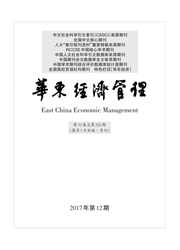

 中文摘要:
中文摘要:
文章在测算中国30个省区1995-2015年碳排放强度的基础上,通过异质性PS收敛方法确定“俱乐部收敛”类型,解决EKC同质性假设的问题,构建碳排放强度的空间面板数据计量模型,对各类型区域碳排放强度EKC曲线的拐点及峰值时间进行实证检验。研究结果显示:考虑空间相关性与空间异质性后,中国碳排放强度EKC模型的估计结果更加稳健,五种类型区域碳排放强度EKC假设成立;“十三五”期间中国经济增长率为6.5%的目标条件下,模型估计结果进一步证明中国将在2020年实现碳排放强度与经济增长的“脱钩”;中国经济发达的省区已经率先实现碳排放强度的达峰目标,但是如果经济落后的省区不能如期抵达峰值,必将影响全国碳排放峰值的时间和目标。从碳排放强度EKC曲线拐点来看,中国差异化碳减排政策应该根据各类型区域经济增长与碳排放的发展阶段,通过政府引导作用促使碳排放EKC曲线变化更加平缓,保证经济发展的同时分区域有重点地控制并减少碳排放总量,进而确保各省区能够根据地区发展实际科学落实国家节能减排任务;同时,提高资源的利用效率,促进异质性类型区域实现碳排放强度收敛于共同稳态,进而扭转中国经济增长导致环境恶化的不利局面。
 英文摘要:
英文摘要:
On the basis of the measurement of 30 provinces' carbon emissions intensity from 1995 to 2015, The paper determines the "club convergence" by the PS test method of heterogeneity convergence, builds up the spatial panel data econometric model, and estimates empirically the inflection point of EKC curve and the time of peak for the carbon emissions intensity of various regions. During the "13th Five-Year", if it is estimated that the target of economic growth is up to 6.5%, the results further prove that the overall "decou- piing" of carbon emissions intensity in China will be realized by 2020. Some developed provinces and regions have been the first to achieve the goal of the peak of carbon emissions intensity, but if some less-developed provinces cannot reach the peak, that will be bound to the peak time and target of carbon emissions in China. In view of the inflection point of EKC curve, the government should implement some policies to reduce the carbon emissions according to the stage of regional economy and carbon emissions of various types. At the same time, the government should guide and promote carbon emissions EKC curve to be more gentle, control and reduce carbon emissions while maintaining regional economic development, and ensure that each province can implement the national task of energy-saving and emission reduction according to the regional development. Finally, the government should improve the efficiency of resource utilization, promote the heterogeneous region to converge to the common steady state, so as to reverse the condition that the economic growth leading to the deterioration of environment in China.
 同期刊论文项目
同期刊论文项目
 同项目期刊论文
同项目期刊论文
 期刊信息
期刊信息
